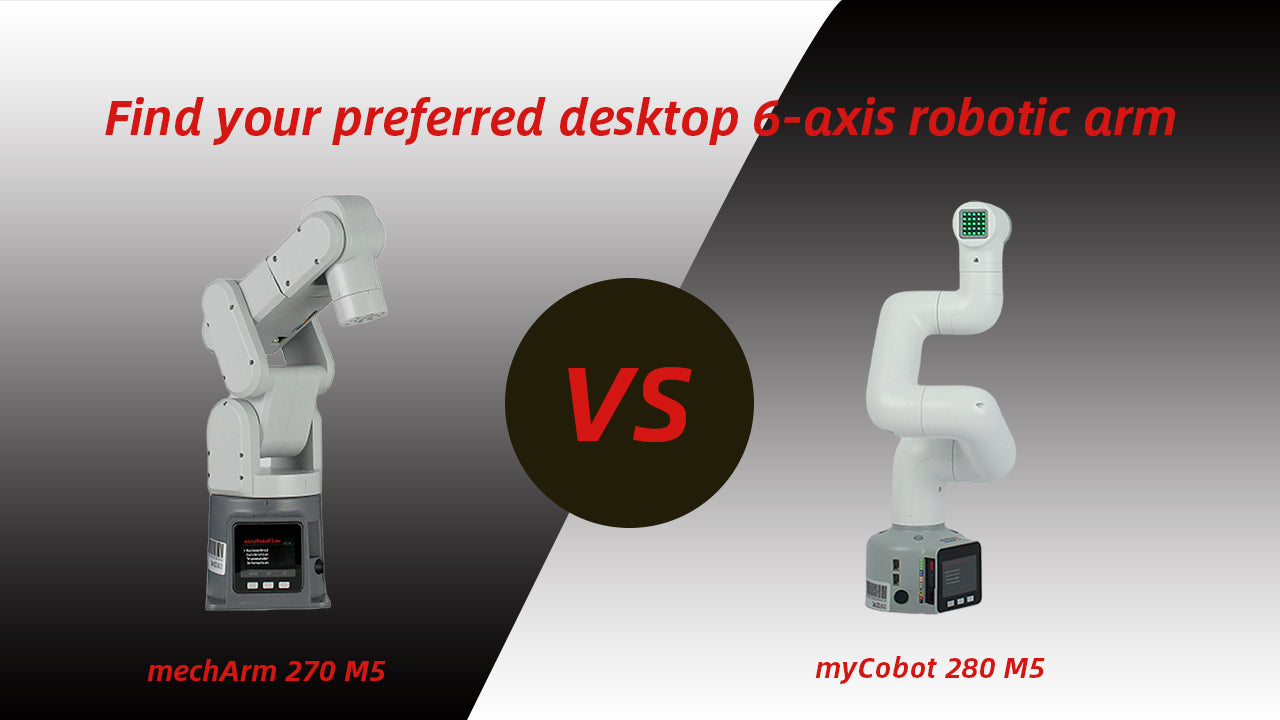初心者向けのデスクトップ 6 軸ロボットアームの選び方

教育用ロボットでロボット工学を学ぶ
急速に進化する今日のテクノロジー環境において、自動化の進展は避けられず、ロボットアームへの関心が高まっています。複雑な産業用ロボットに取り組む前に、教育用ロボットから学ぶことは素晴らしい方法です。教育や科学研究のためのロボットアームは数多くありますが、ロボット工学市場においてどのように選べば良いのでしょうか?
今回は、ロボット工学を学び、短期間でプロトタイプを作りたい初心者に最適な、小型デスクトップ6軸ロボットアームを2つご紹介します。2つのロボットを比較し、ニーズに最適なロボットを見つけるお手伝いをします。
この記事の内容:
産業用ロボットと協働ロボットの違いは何ですか?
産業用ロボットアーム
産業用ロボットは、危険な環境下における高速かつ高負荷の作業に優れています。これにより、生産量の増加、企業の運用コストの削減、そして危険な作業への人間の介入を排除することで作業員の安全性向上につながります。産業用ロボットは、その強力な動作から安全を確保するため、ケージなどの保護区域に設置されることが多いことに留意する必要があります。
協働ロボットアーム
協働ロボットは、産業用ロボットとは異なり、小型で軽量で、センサーや力制御などの安全機能を備えています。これにより、人間と安全に連携して作業できるため、協働作業に最適です。
デスクトップ ロボット アームを選択する理由
小型デスクロボットは、学習用途に特化して設計されています。手頃な価格で使いやすく、ピッキングや配置、動作制御、視覚追跡などをサポートします。

- ほとんどの産業用ロボットアームは中心対称構造になっており、協働型ロボットアームはコボット構造になっています。
マイコボット 280 M5スタック
myCobot 280 には4 つのバージョンがあり、M5 Stack は複数の機能を備えた M5Stack-Basic を搭載した 6 軸協働ロボットで、コボット構造で設計されています。
メカアーム 270 M5スタック
mechArm 270 M5 Stack は myCobot に似ていますが、mechArm の構造は中心対称です。
開発とプログラミングのオプション
myCobotとmechArmはどちらも、ユーザーが開発環境を素早く構築し、アームの制御ロジックを習得できるように設計されています。Python、C++、C#、JavaScriptといった一般的なプログラミング言語をサポートしています。Elephant Roboticsは、環境構築からロボットアームの制御まで、あらゆることを網羅した詳細なチュートリアルを含む、ロボットアーム開発環境を素早く構築するためのGitbookを提供しています。

ROSデモ
スライダーを使用してmyCobotを制御します。

プログラミング用のMoveIt。経路計画と障害物回避を可能にします。

これらをAI キットと統合することで、ユーザーは物体認識や把持などのタスクにおけるマシンビジョンやロボットアームの調整などの概念を探求できるようになります。

- ロボットアームの端にあるインターフェースは LEGO インターフェースであり、Elephant Robotics のアクセサリを使用したり、3D プリントで独自に作成したりして、開発ニーズを満たすことができます。
myCobot 対 mechArm
それぞれの構成を見てみましょう。違いは何でしょうか?
| 仕様 | メカアーム 270 M5 | マイコボット 280 M5 |
|---|---|---|
| 構造 | 中心対称 | コボット |
| 自由度 | 6 | 6 |
| ペイロード | 250グラム | 250グラム |
| 作業半径 | 270mm | 280mm |
| 測位精度 | ±0.5 mm | ±0.5 mm |
| 重さ | 1000グラム | 850グラム |
| マスターコア | ESP32 | ESP32 |
| ステアリングギアタイプ | 高性能サーボモーター | 高性能サーボモーター |
| 主周波数 | 240MHzデュアルコア | 240MHzデュアルコア |
| コンピューティングパフォーマンス | 600DMIPS | 600DMIPS |
| 動作寿命 | 500時間 | 500時間 |
| SRAM | 520KB | 520KB |
| ブルートゥース | デュアルモード Bluetooth 2.4G/5G | デュアルモード Bluetooth 2.4G/5G |
| コアフラッシュ | 4M | 4M |
| プログラミング | Python、C++、C#、JavaScript | Python、C++、C#、JavaScript |
| 関節回転速度 | J1: -165°~+165° J2: -90°~+90° J3: -180°~+65° J4: -165°~+165° J5: -115°~+115° J6: -175°~+175° |
J1: -168°~+168° J2: -135°~+135° J3: -150°~+150° J4: -145°~+145° J5: -165°~+165° J6: -180°~+180° |
- 動作半径、位置決め精度、関節可動範囲の違いは、構造の違いにより生じます。
構造と安定性

- 中心対称構造(mechArm):これは産業用ロボットで最も広く使用されている構造です。MechArmの関節2、3、4は両側支持構造を採用しており、より高い安定性とスムーズな動きを実現します。
- コボット構造(myCobot): UR構造は中央の支柱がないため、作業半径が広く、より柔軟な動きが可能です。ただし、この柔軟性により、中心対称設計と比較して、動作に若干の偏差が生じる可能性があります。これは、支持部がないため、ロボットアームは安定性を保つためにモーターに頼る必要があるためです。
関節回転範囲
メカアーム

マイコボット

- mechArm は動きの点で制限がありますが、myCobot はより柔軟性があります。
選択をする
| 仕様 | メカアーム 270 M5 | マイコボット 280 M5 |
|---|---|---|
| 構造 | 中心対称 | コボット |
| 自由度 | 6 | 6 |
| 測位精度 | ±0.5 mm | ±0.5 mm |
| ペイロード | 250グラム | 250グラム |
| 作業半径 | 270mm | 280mm |
| 関節回転速度 | J1: -165°~+165° J2: -90°~+90° J3: -180°~+65° J4: -165°~+165° J5: -115°~+115° J6: -175°~+175° |
J1: -168°~+168° J2: -135°~+135° J3: -150°~+150° J4: -145°~+145° J5: -165°~+165° J6: -180°~+180° |
| 運動の構造と安定性 | より良い | 普通 |
| 柔軟性 | 普通 | より良い |
| 初心者のための選択肢 | より良い | より良い |
| シナリオ | 教育 研究 ロボットアームの原理を学ぶ 産業用ロボットアームのシナリオ マシンビジョン |
教育 研究 ロボットアームの原理を学ぶ 協調型ロボットアームのシナリオ マシンビジョン |
- 柔軟性と人間と機械のコラボレーション シナリオを優先する場合は、myCobot を選択してください。
- 次の場合は mechArm を選択してください:産業用ロボットアームの方向で安定性と学習性を優先する場合。
初心者にとって、デスクトップロボットアームはロボット工学の世界への入り口として最適です。どちらも教育および個人使用向けに設計された6軸ロボットアームです。
